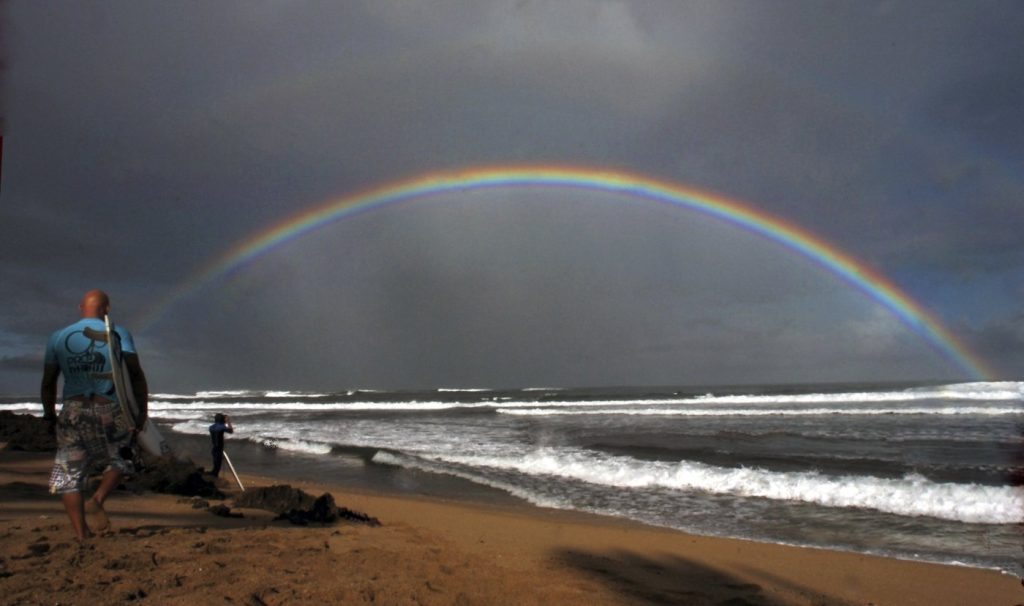HONOLULU (AP) - Hawaii is renowned for its breathtaking rainbows, attributed to the state's regular sunshine, short rain showers, and clean air. A University of Hawaii professor has even labeled Hawaii as the "rainbow capital of the world." Currently, the winter rainy season heightens the likelihood of encountering rainbow displays in the islands.
In Hawaii, rainbows have become symbols of island life, frequently appearing in artwork, on public transportation, and on vehicle license plates. The University of Hawaii sports teams, named after rainbows, exemplify this cultural significance. "For me, rainbows really signify hope and new beginnings," expressed Liane Usher, president of the Children’s Discovery Center in Honolulu, emphasizing the joy they bring to those who see them.
Rainbows form when sunlight refracts through raindrops, creating a spectrum of colors. To spot a rainbow, observers should look when it is both sunny and raining simultaneously, typically opposite the sun. Early morning and late afternoon provide the best conditions for larger and higher rainbows, as the sun's position is lower on the horizon. Professor Steven Businger from the University of Hawaii at Manoa notes that trade winds contribute to the frequent rain showers while allowing ample blue sky for sunshine to penetrate. The pristine air quality of Hawaii further enhances these conditions, as other regions often harbor more pollutants like dust and pollen.
The Hawaiian language possesses approximately 20 different terms for rainbows, encompassing unique words for rainbow fragments and those positioned low on the horizon. In Native Hawaiian culture, rainbows symbolize divine or supernatural power. Sam ‘Ohu Gon III, a senior scientist and cultural adviser at The Nature Conservancy, relays that rainbows are associated with Kane, one of the principal deities in Hawaiian tradition. Historically, approaching a rainbow was believed to lead one closer to a divine entity or a powerful figure. In another instance, a rainbow appears over a Hawaiian princess's home, signifying her suitor's arrival, a man of extraordinary strength.
To Native Hawaiian cultural practitioner Hinaleimoana Wong-Kalu, rainbows signify the presence of an "aumakua," or a deified ancestor. She describes rainbows as spiritual symbols of protection, a reminder that loved ones are watching over those who remain. This connection to the spiritual realm exemplifies the deep cultural roots associated with rainbows in Hawaiian tradition.
Rainbow imagery is pervasive in Hawaii, from public structures to sports team branding. The University of Hawaii's men's athletic teams became known as the Rainbow Warriors, while the women's teams were called Rainbow Wahine, meaning "women" in Hawaiian. The origin of this mascot traces back to 1924 when a rainbow graced the scene during a game against the Oregon Aggies, leading reporters to name the team the Rainbows. The term "Rainbow" was removed from the football team's name in 2000 due to concerns regarding its association with the LGBTQ+ community but was reinstated in 2013.
As climate change continues to impact weather patterns globally, researchers like Kimberly Carlson have contemplated its potential effects on rainbows. Carlson's analysis suggests that by 2100, regions such as Brazil and parts of Central Africa may experience a decline in rainbow prevalence. Conversely, areas that receive more rain instead of snow may see an increase in rainbows, with Alaska being a notable example. In Hawaii, scientists predict rainbows will remain abundant, though extended dry spells may reduce their occurrences on drier leeward sides, particularly affecting locations like Maui and the Big Island.
Rainbows hold cultural significance and encapsulate moments of joy and reflection for many people in Hawaii. As Businger articulates, "Rainbows are a cultural touchstone for us. They cause us to stand still and for a moment, forget about the past and the future." These vibrant displays continue to enchant residents and visitors alike, making them an integral part of Hawaiian identity.










